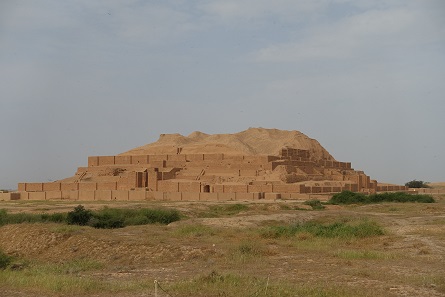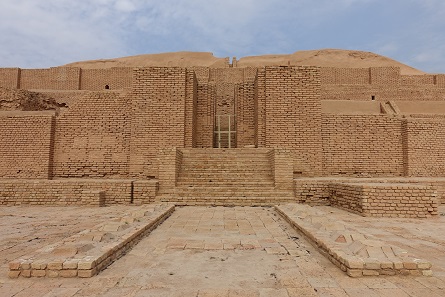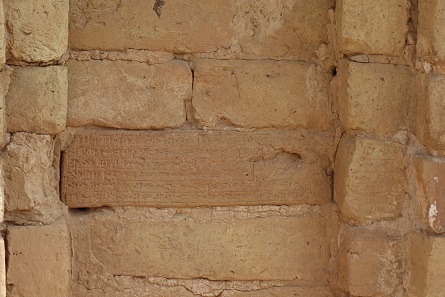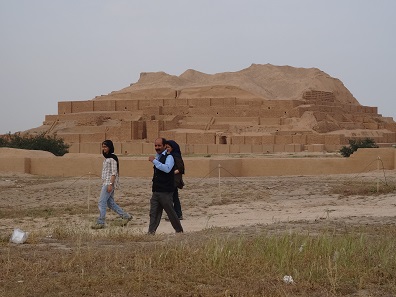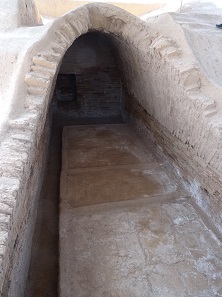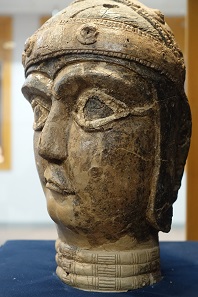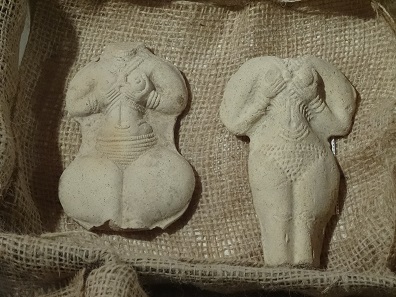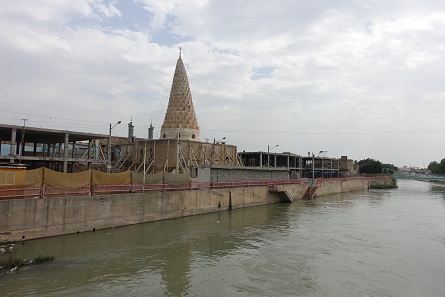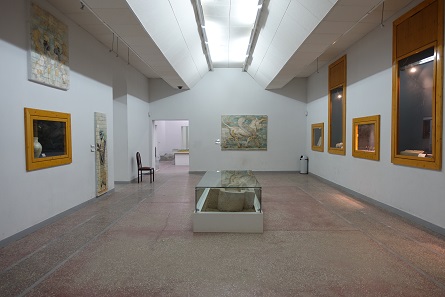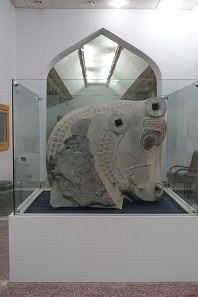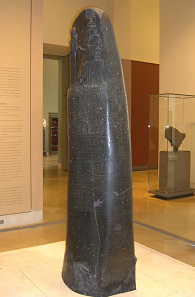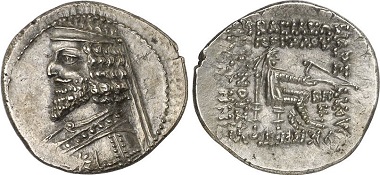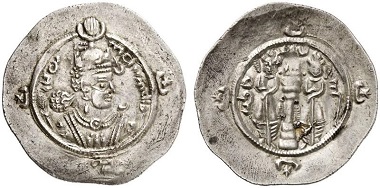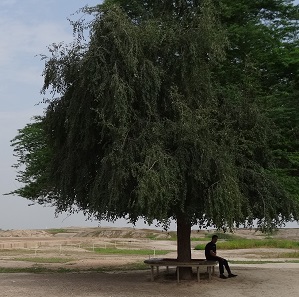by Ursula Kampmann
translated by Teresa Teklic
September 29, 2016 – Admit it: Chogha Zanbil is not exactly on your list of things-you-need-to-see-before-you-die. It wasn’t on mine, which merely proves how unreliable such lists are. Chogha Zanbil is incredibly fascinating! The Persian Susa, on the other hand, which I had really looked forward to seeing, can be crossed off your must-see list in good conscience if you ask me.
The ziggurat of Chogha Zanbil, the most impressive leftover monument of the Elamite king Untash Napirisha, built in honour of the god Inshushinak. Photo: KW.
Monday, 14 March 2016
As a cultural tourist, this is what you call a rest day: wake-up call at 6.30 am, breakfast at 7.30, in the bus by 8.00 and only a two-hour drive before we arrived in Chogha Zanbil. The name didn’t ring familiar at all and neither did the Assyrian name, Dur Untash. A mistake, as it turned out, because what we got to see there more than merits its title as UNESCO World Heritage Site.
Ascent to the top of the temple mountain. Photo: KW.
We saw the best-preserved ziggurat that exists in Mesopotamia. And that was enormously impressive. The size alone! I had always imagined the Tower of Babel to be a matter of somewhat smaller scope but on seeing this five-stepped, hill-shaped temple it suddenly made sense that the construction of such an edifice would seem like megalomania and heresy to pious contemporaries.
Bricks with cuneiform inscriptions are incorporated into the walls everywhere in the building. Photo: KW.
Admittedly, we don’t know very much about the builder (a cuneiform document that is currently kept in Berlin might date Untash Napirisha to the years between c. 1275-1240 BC), nor about the god that the temple was dedicated to (Inshushinak seems to have been none other than the main god of the Elamites, responsible for law and order and the wellbeing of his country). And this is considering that what the archaeologists call the Elamite Empire existed almost 2,000 years – of course with intermissions. So much about the ambition (or lack thereof) of wanting to be remembered by posterity. After all, Untash Napirisha built eleven temples on round about 250 acres in Chogha Zanbil – it is likely that more were in the planning – and five palaces.
This cultural heritage site, which, by the way, was the first ever UNESCO World Heritage Site in Iran, was discovered in 1935 from the air, when the area was being searched for oil. And today test drillings are being undertaken very close-by, which, according to several archaeologists, jeopardizes the statics of the building.
The Iranian people are proud of their history. They like visiting their cultural heritage Photo: KW.
Anyway, the point is that busses with tourists would have flocked to the parking place in Europe. Here we were pretty much left to ourselves. One Iranian family was on a day-trip, a few construction workers who were rain-proofing the upper brick walls with a big bucket full of tar (maybe not the most modern way of restoration but still) and our group. We walked down the newly prescribed path – cultural heritage comes with its obligations, and wondered in amazement. We found that the thing was equally impressive on all sides only to then, deeply impressed, get onto the bus again.
A look into the vault of Haft Tepe. Photo: KW.
A few kilometres further from the ziggurat we set off to Haft Tepe, another one of those excavations that never made it onto my bucket list. And that in spite of the fact that not only royal tombs were found in Haft Tepe (=Seven Hills), but also a settlement from the mid-2nd century BC.
Its ruler – a rather small fry who still thought of himself as pretty important – made exact arrangements that, for a certain time after his death, four girls were to keep watch at his grave. And so they wouldn’t get any ideas of stealing anything from his precious tomb inventory he determined how loosely their sparse dress should be attached to their bodies…
Death mask, found in Haft Tepe. Photo: KW.
Next to the royal tomb there is another vault, in which 23 people were buried simultaneously and very close to each other. No wonder that everybody immediately thought that those 23 servants may have been sacrificed to accompany the ruler on his last journey. If that’s what really happened? We don’t know.
But our imagination had been sparked. The excavation itself didn’t help much with that. It was, after all, nothing but two holes in the ground: one with rammed soil, the other, somewhat more royal, with a floor of burned tiles.
Urn with skeleton remains of Haft Tepe. Photo: KW.
Have I complained on previous travels that museums in other countries were closed? Not so in Haft Tepe. Here the custodian of the local museum even approached our guide and reminded him not to miss out on the museum. So we behaved and went in to see several local finds. Well, it wasn’t easy for the museum. Nothing could sweep us off our feet after the silver treasure of Khorramabad.
Female votive statuettes. Photo: KW.
One thing I did find pretty though: the votive offerings, female statuettes, which were broken in two in a ritual at the sanctuary, either to remove them from profane life or perhaps so that the faithful could take a part of the statue home as a reminder of his pilgrimage and for future consolation.
The rumour had spread on the bus that we would be at the hotel at 4 or 5 pm already today. Well, hope dies last, but when we were still having lunch at 1 pm, with the visit to Susa still ahead of us, I couldn’t quite believe in this promise any longer.
A look at the Tomb of (the prophet) Daniel at Susa. Photo: KW.
And so we came to Susa, or Shush, as the city is called today. It was weird. The moment we stepped out of the bus we felt uncomfortable. When elsewhere people had greeted us friendly and respectfully asked us where we came from, here a group of pushy young men surrounded us with loud “helloes”. Women turned away their faces and Ms Hodel advised us to hold on tight to our purses.
The sugarloaf-like sanctuary of Daniel. That’s all you get here. I didn’t go in. Photo: KW.
First up on the agenda was the mausoleum of Daniel, yep, right, of the prophet Daniel, who, according to Dan 6, was thrown in the lion’s den by the Persian king, which the former supposedly survived, and which supposedly convinced the latter to worship Daniel’s god himself.
Strictly speaking Daniel doesn’t belong to the prophets sanctioned by a mention in the Koran, but people still like him and so his sanctuary enjoys great popularity.
Art-historically the only remarkable thing about it is its characteristic sugarloaf-roof, a landmark of the region. The interior dates back to Qajar times and, so I heard, looks just like the mausoleum in Qazwin. I say “so I heard” because when we were asked to put on a chador once more, the women among us refused. It’s not that I generally have a problem with the chador or refuse to defer to religious customs. But it was more than 30°C hot, it was sticky, and I already felt the heat getting to my head underneath the headscarf. Also, the people were unfriendly. A rude guy had a go at our group and impertinently pushed us away with his hands to make space for him and his family. A woman who’d just come to pray turned on her heel when she saw us. I know when I’m not wanted. And here, in Susa, at the mausoleum of the prophet Daniel one was perfectly fine without me.
Not for tourists, the stands on the bazar. Please note the large lump of rock sugar on the right. Be careful when you put Iranian rock sugar in your tea: there is a small piece of twine at its core, which of course doesn’t dissolve. Photo: KW.
So we remained standing and waiting in the shade of the bazar until the men, who’d still wanted to take a look inside, were back and then it was off to that which has been left over of the famous city of Susa.
A look into the museum. Photo: KW.
First to the museum. Open, at least. And you could even acquire an archaeological guide about Persia’s landmarks in English. Which I did, of course. The man at the entrance was quite surprised to finally have sold a book for once, and for the royal sum of 300,000 riyals – that is not even 8 euros. In return I got some 300 pages in close type and close to 60 plates.
One of the monumental bull’s head that used to adorn the Persian throne room. Photo: KW.
This museum, too, offered little insights into the former glory of the city of Susa. There was a monumental bull’s head that used to adorn the columns which carried the cedar wood roof in the throne room of the Persian king once. Still, that was as good as it got.
The stony parts of a bull’s column – not in Iran, but in the Louvre/Paris. Photo: KW.
Which might have been due to the fact that Susa was excavated by the French, who saved their best pieces for the Louvre.
A look at Susa. Photo: KW.
Ask any Western Asian archaeologist you want. Susa is the place to be. Because you can reconstruct the archaeological horizons of the different settlements from the 4th century BC until the 13th century AD there.
The Code of Hammurabi. Today in the Louvre / Paris. Photo: KW.
The Susa I period is early Neolithic Age with beautiful colourful ceramic. With Susa III the proto-Elamites arrive. They left behind 1,550 cuneiform tablets with proto-Elamite script in their settlement. During the Susa IVB period, the city was part of the Accadian Empire, only to become independent again by the end of the epoch. Middle Elamite, Neo-Elamite, it’s like a film playing in the archaeologists’ heads that features several of the most important finds of Western archaeology in the lead roles. Not only the almost life-sized bronze statue of Napirasu, spouse of the creator of Chogha Zanbil, Untash-Napirisha, was found here but also the Code of Hammurabi.
In 647 Ashurbanipal conquered the city and destroyed the ziggurat, which was probably even bigger than the one preserved in Chogha Zanbil today. Despite the looting that is said to have lasted one month and 25 days the former inhabitants of the city decided to return.
The former throne room of the Achaemenids. Photo: KW.
Under the Achaemenids Susa was expanded into a residence. Susa is the only Persian residence mentioned by name by Herodotus. Dareius I built a palace here, which we pretended to explore. Let’s put it like this, our imagination fought a heroic fight against the deplorable remains of former glory.
Seleucus I, 312-281. Tetradrachm, Susa, after 305/4. From Gorny & Mosch auction sale 236 (2016), 572.
Alexander took over Susa and got a haul of 50,000 talents of silver, which he had minted into tetradrachms to pay his legionaries. Of course there was a mint in Susa and it was busy under Seleucid rule. The Seleucids had set up an important administrative centre her. Susa was the largest city of the empire after Seleukia. And many traces of Greek culture were secured here indeed.
Phraates III, 70-57. Drachm, Susa. From Gorny & Mosch auction sale 204 (2012), 1628.
When exactly Susa changed hands from the Seleucids to the Parthian Arsacids we don’t know. What we do know is that Phraates IV renamed the city Phraata in 30 BC. In 116 Emperor Traian succeeded in bringing Susa under Roman control – which, however, remained but an interlude (more about the Roman-Parthian-Sassanid conflict in the upcoming episode). Even though the Parthians were in control here, the Greek institutions continued to operate until the middle of the 1st century AD as we know from inscriptions. After that Susa slowly declined in importance.
Ardashir III, 628-630. Drachm, Susa, 629. From Gorny & Mosch auction sale 225 (2014), 1719.
Ardashir I conquered Susa in 224, destroyed the city and had it rebuilt right after, something Shapur II repeated in 339 with 300 elephants (there’s definitely room for discussion about the Sassanid understanding of efficiency). Susa must have served as a residence for Sassanid rulers at times and was known as the centre of gold trade and silk weaving.
In 639 the Arabs took the city (destroyed it, rebuilt it). The archaeological history of Susa only ends in 1259, when it was destroyed by the Mongols (and not rebuilt).
The Eastern courtyard of the Achaemenid palace, in case you hadn’t already noticed. Photo: KW.
And that’s it about the impressive history of the city. You couldn’t see much of it anyway. Plus, it had gotten even hotter by now. I didn’t even dare lift my headscarf because I was drenched in sweat underneath.
Dutifully I followed Ms Hodel, first along the small archival rooms, where the Persian administration was housed. Then to the throne room, where our local guide, not wanting to miss the rare opportunity to make some money, showed us his reconstruction sketches. That was necessary. The ruins didn’t give away anything of their former splendour. Yes, you can see the enormous platforms, which once were the foundation for even more enormous columns, you can imagine where the Persian king once sat on his throne and several column remains convey a sense of how high the columns must have been once, but that’s about it.
Somehow all the excavation of Susa seemed to be telling us was: Sic transit gloria mundi.
No matter how important you think you are, sooner or later sweaty tourists will be trampling along your most sacred of the sacred, dying for a bit of shade.
Susa’s touristic infrastructure. Photo: KW.
While a large part of the group was still curiously viewing the ground plan of the craftspeople’s settlement, I’d had it. I sat down on a bench under a tree. At least there was a bench. But that was about all there was in terms of infrastructure. It was here in Susa that, for the first time, I realised what I’d been missing so much at all the Iranian excavations. In Turkey, in Greece, in Italy you are never far from the next café. You can always refresh yourself with a cold juice or a hot tea in an idyllic setting.
Here touristic comforts are amiss. A bench in the shade is all the luxury you can get. The only beverages available are the omnipresent water on the bus, a tea once in a while, served by our bus driver Nadir and his assistant Mustafa – and that’s it. Yes, we’re not having so many picnics because it’s idyllic but because there are so few restaurants geared towards tourists’ needs.
If you travel Iran you should know that it’s highly fascinating. That there are many unique landmarks. But that normal touristic standards don’t apply here.
The only place for repose is your hotel and not every hotel is equipped in a way that provides such rest.
Be that as it may, we got back home shortly after 6.30 pm. A quiet day? Nothing of the sort. Well, everything’s relative. Tomorrow we’ll head out at 6.00 am, that means getting up at 4.30. Not even the most dutiful tax inspector would call this a holiday.
You can find all episodes of my Iranian travelogue here.





